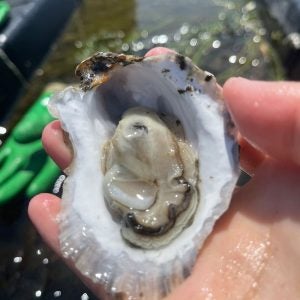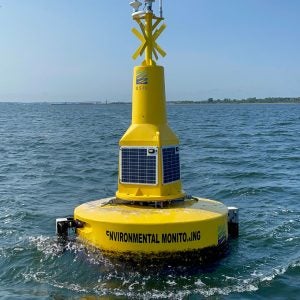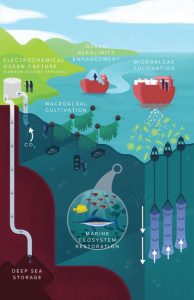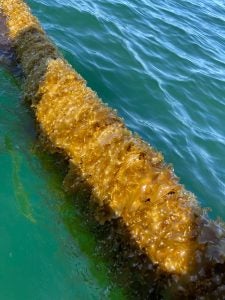Coastal aquaculture
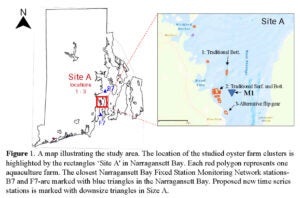 Our lab aims to address challenges in Rhode Island’s oyster farming industry. The study focuses on evaluating the effectiveness and operationality of alternative surface gear compared to traditional cultivation techniques, as well as understanding the influence of water quality on oyster health. In partnership with local oyster farms, our lab will deploy high-resolution water quality monitoring systems to gather data on factors such as temperature, salinity, oxygen levels, pH and nutrients while also monitoring oyster health and production from March 2024 to Feb 2025. This comprehensive approach is designed to support Rhode Island’s aquaculture industry by providing data-driven insights into best farming practices and the potential impacts of environmental factors on oyster production.
Our lab aims to address challenges in Rhode Island’s oyster farming industry. The study focuses on evaluating the effectiveness and operationality of alternative surface gear compared to traditional cultivation techniques, as well as understanding the influence of water quality on oyster health. In partnership with local oyster farms, our lab will deploy high-resolution water quality monitoring systems to gather data on factors such as temperature, salinity, oxygen levels, pH and nutrients while also monitoring oyster health and production from March 2024 to Feb 2025. This comprehensive approach is designed to support Rhode Island’s aquaculture industry by providing data-driven insights into best farming practices and the potential impacts of environmental factors on oyster production.
Ocean Alkalinity Enhancement Through Coastal Liming
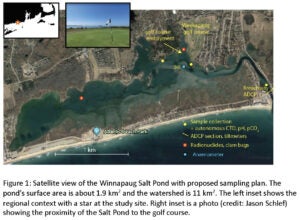 The mCDR 2023 program is designed to investigate the potential of coastal terrestrial liming as a means of marine Carbon Dioxide Removal (mCDR) through ocean alkalinity enhancement. By focusing on a coastal lagoon near a golf course, the multi-institutional team, led by PI Jaime Palter, will scrutinize the effects of applying calcitic limestone on the lagoon’s carbon composition. Our lab will gauge the speed and efficiency at which alkalinity from terrestrial liming transitions to the coastal waters and its capability for carbon capture, as well as its potential effects on marine life, exemplified by clams. In collaboration with advanced Regional Ocean Modeling Simulations, the team will forecast the wider mCDR potential of terrestrial liming across the U.S. East Coast.
The mCDR 2023 program is designed to investigate the potential of coastal terrestrial liming as a means of marine Carbon Dioxide Removal (mCDR) through ocean alkalinity enhancement. By focusing on a coastal lagoon near a golf course, the multi-institutional team, led by PI Jaime Palter, will scrutinize the effects of applying calcitic limestone on the lagoon’s carbon composition. Our lab will gauge the speed and efficiency at which alkalinity from terrestrial liming transitions to the coastal waters and its capability for carbon capture, as well as its potential effects on marine life, exemplified by clams. In collaboration with advanced Regional Ocean Modeling Simulations, the team will forecast the wider mCDR potential of terrestrial liming across the U.S. East Coast.
Ocean Acidification
Atmospheric carbon dioxide (CO2) has increased from the pre-industrial period of 280 ppm to today’s ~420 ppm (in 2022), and is expected to continue to increase unless global action is taken to curb emissions. Throughout the history of human emissions, the oceans have performed an essential service by absorbing 25% of all CO2 emissions since the Industrial Revolution. The continuous uptake of CO2 by seawater causes a process known as ocean acidification (OA), whereby a cascade of chemical reactions causes an increase in acidity and alters the forms and availability of inorganic carbon to marine life. In many regions, the shellfish industry is the “canary in a coal mine” for OA because culturally and commercially important shellfish have difficulty maintaining their external calcium carbonate skeletons or shells under acidified conditions. Future impacts of OA on coastal ecosystems have the potential to negatively influence a wide range of socioeconomic factors, including food security, livelihoods and public health.
Narragansett Bay is home to several decadal time series in chemical, physical and biological properties, and is one of the most rapidly warming estuaries in the USA. Our lab is leveraging existing monitoring programs, deploying new autonomous instrumentation, and utilizing a coastal biogeochemical model to quantify the variability of OA and the mechanisms driving its change.
The work will ultimately be used for science-driven decision-making for sustainable resource management.
Marine Carbon Dioxide Removal
The Intergovernmental Panel on Climate Change (IPCC) suggests that intentional carbon dioxide removal (CDR) approaches will be required to stabilize global atmospheric temperatures at 1.5 °C – 2 °C above the preindustrial baseline (IPCC 2018). IPCC analysis suggests that we will need to extract 5.5 GT CO2 per year out of the atmosphere by 2100 to limit global warming to 1.5 °C (IPCC, 2018). This CDR will mostly offset legacy emissions and emissions that cannot be avoided. Oceans are likely to play an important role in any carbon dioxide removal strategy that operates at the required scale, yet any ocean CDR approach must also be weighed by whether it exacerbates or ameliorates OA. My lab is interested in examining the effectiveness and side effects of different ocean-based CDR approaches (i.e., alkalinity enhancement, macroalgae cultivation) using biogeochemical models and autonomous observations.

